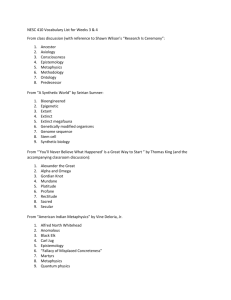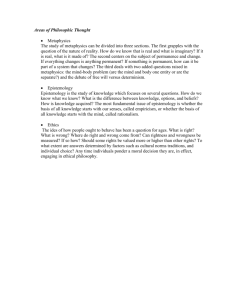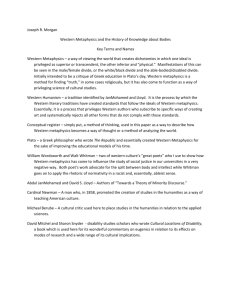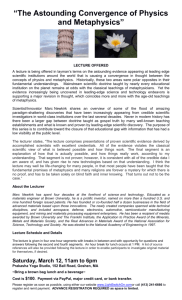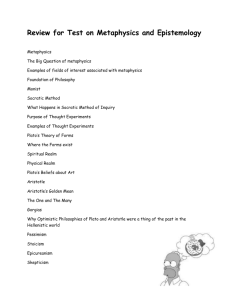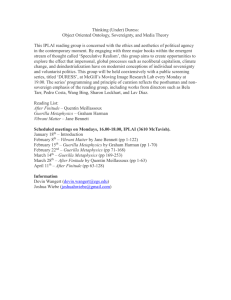0715CD173
advertisement
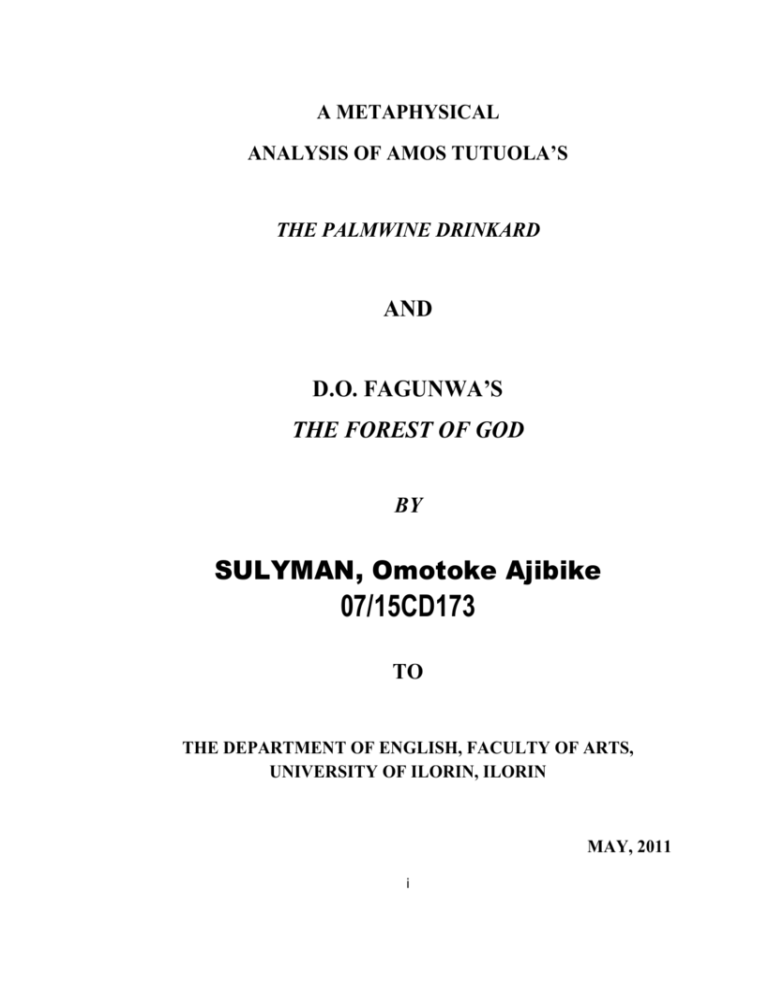
A METAPHYSICAL ANALYSIS OF AMOS TUTUOLA’S THE PALMWINE DRINKARD AND D.O. FAGUNWA’S THE FOREST OF GOD BY SULYMAN, Omotoke Ajibike 07/15CD173 TO THE DEPARTMENT OF ENGLISH, FACULTY OF ARTS, UNIVERSITY OF ILORIN, ILORIN MAY, 2011 i CERTIFICATION This project has been read and approved as meeting the partial requirement for the Award of Bachelor of Arts Degree in English in the Faculty of Arts, University of Ilorin, Ilorin, Nigeria. __________________ Dr. J. Balogun Supervisor ________________ Date __________________ Dr. S.T. Babatunde Head of Department _________________ Date __________________ External Examiner _________________ Date ii DEDICATION I dedicate this study to God Almighty, who has seen me through my academic programme, my parents especially my mum, Miss Olatokunbo Kadara, my sisters and brother and my friends Yemmy, Angela, Nneka, Bisola and Funmi. Thanks for all your support. iii ACKNOWLEDGEMENT I appreciate my supervisor, Dr. J. Balogun for his fatherly advice and the time he spared to make my project a success. I am grateful to my family for their support especially my mum and my precious and supportive big daddy Grp.Captain.B.O.A. Sotubo(Rtd) they’ve been with me through thick and thin. I also want to thank my lecturers who have one way or the other imparted on my knowledge, I appreciate you all and God bless you all. Finally, I give all the glory to God Almighty for his love, favour and mercies. Thank you God. iv ABSTRACT This work focuses on the metaphysical approach as portrayed by Amos Tutuola’s The Palwine Drinkard and D.O Fagunwa’s The Forest of God. This study shows how metaphysics was used in the two plays. Metaphysics is based on the use of myths, gods, medicine and use of god like creatures. The novels are used to show these facts.Research done has helped shed more light on what entails metaphysics and how it exists in our world and the belief people have in it. v TABLE OF CONTENTS Title page i Certification ii Dedication iii Acknowledgement iv Abstract v Table of contents vi-vii CHAPTER ONE Background to the Study 1-3 Scope and Limitation 3 Justification 3 Organization of Chapters 4 Authorial Background 4-6 Methodology 6 End notes 7 CHAPTER TWO Literature Review 8-9 Idealist Metaphysics 9-11 Materialist Metaphysics 11-12 Dialectal Materialism 12-15 vi End notes 16 CHAPTER THREE The Metaphysical Approach in D.O. Fagunwa’s The Forest of God 17-24 End notes 25 CHAPTER FOUR The Metaphysical Approach in Amos Tutuola’s The Palmwine Drinkard 26-32 End notes 33 CHAPTER FIVE Summary and Conclusion 34-35 Bibliography 36-37 vii CHAPTER ONE INTRODUCTION Background to the Study The word “metaphysics” is derived from two Greek words “Meta” which means “after” and “physika” which means physics (or nature). Metaphysics literally means after nature or after physics which deals with things of the mind, soul and other things outside this world. The indepth meaning of metaphysics is not known because people often, mistake it with similar meaning in contexts. Metaphysics is a branch of philosophy. Its definition may not be as definite as one could know. However, there are different types of definition of metaphysics by different scholars like Aristotle, Democritus and Plato. The Oxford dictionary (1995: 533) states that metaphysics is “the branch of knowledge dealing with the nature of existence, nature of truth and that of knowledge” Aristotle in his Understanding Metaphysics (1903:170) defines metaphysics “as the four elation of all sciences as it is the science of being with the natural world and beyond”. In Aristotle’s case the word “beyond” refers to the supernatural world or realm. Metaphysics could also be the integration of the 1 natural world of man with the other world of the unknown according to Aristotle, it is the science of reality. The two novels under study Tutuola’s. The Palmwine Drinkard and Fagunwa’s The Forest of God are elemental case studies of metaphysics as they have it in them , elemental case studies of metaphysics from the beginning to the end. In their own unique way, these two writers express their aesthetic visions through their characters which emanates from a common stock of tradition, the Yoruba metaphysics mythology and collective, apprehension of the universe. Abiola Irede in Tradition and Yoruba Writers (1975: 79) comments on Fagunwa and Tutuola that: The significance of their work is this inherent in the symbolic framework and connotation of their novels. A simple but valid interpretation of Tutuola and Fagunwa’s pattern of situation in their novels suggests that man stand a dynamic, supernatural, moral and spiritual world lived in by obscure forces and this of course is a mythical representation of the existential condition of man as expressed in Yoruba thinking.(79) 2 Tutuola and Fagunwa’s personal beliefs of metaphysics was transferred to their use of characters like in the Forest of God we have Anjonnu – Iberu, the gnome of the ant hill, Death and so many more while in The Palmwine Drinkard we have the Incomplete gentleman, The half-bodied baby, Dance, Song and Drum and other characters. The use of charms which he used to prove his power in The Forest of God, his beliefs in ghosts and also the turning into a bird, the talking trees all portray the metaphysics in this novel. Although, they both use almost the same thematic basis for their works, Tutuola failed in the literary tradition of which Fagunwa was a forerunner as most of the things in The Palmwine Drinakard are direct translation from Yoruba to English. Scope and Limitation These two fictional works have been used to give better interpretation of metaphysics as a branch of study. The range and scope therefore were emphasis on various views of metaphysics as depicted Fagunwa and Tuituola. Justification This research work will go further in buttressing the point that the forces above and below man are not just fiction or fallacy but real and will portray the aesthetics of metaphysics through this related works and personal interpretation. 3 Organization of Chapters This study or research has five chapters. Chapter one is the general background to the study and also the introduction. While chapter two consist of literature review which sought to review what scholars have said about metaphysics. Chapters three and four deals with the analysis of metaphysic in the two texts studied The forest of God and The Palmwine Drinkard respectively. And finally chapter five is the summary and conclusion of the research. Authorial Backgrounds Amos Tutuola (1920 – 1997) He was born in the city of Abeokuta in 1920. His parents were Christian cocoa farmers. At the age of twelve he started to attend the Anglican Central School in his home town. His formal education lasted only five years because he had to leave after the death of his father to learn a trade. He went to Lagos to train as a blacksmith in 1939 and from 1942 – 1945 he practiced his trade for the Royal Air Force in Nigeria. After the war, Tutuola worked with Lagos Department of Labour as a messenger and as a storekeeper for the Nigerian Broadcasting Corporation. In 1983, he traveled to the United States to become an associate of the international writing programme at the University of Iowa. He got married and had six children, though highly educated he used Yoruba English for his works. 4 His first novel The Palmwine Drinkard published in 1952 attracted enormous criticism from within and outside the country. As Dylan Thomas said “The book was brief, thronged, grisly and bewitching” Moore (1962:39) Lindfors (1973:32) also stated that “it was delightfully odd and unexpected. Tutuola’s other work include My life in the Bush of Ghosts (1952), Simbi and the Satyn of the Dark jungle (1956). He died of hypertension in 1997 as he was aptly described by an American author Michael Swamwick in his Profile of Amos Tutuola (1997:59) who stated that: “I will always detest that I never had the opportunity to meet the man, what an excellent company he must have been what a fine laugh he must have had!. Daniel .O. Fagunwa (1903 – 1963) He was born in Oke-Igbo in the year 1903. He taught between 1930 – 1939. He won a British Council Scholarship and left Nigeria for Britain in 1946. He came back to become an education officers in 1955 – 1959. At this time he had been noted as a literary figure who was interested in his mother tongue. His work Ogboju Ode ninu Igbo Irumole was published in 1939 and his Igbo Olodumare was published in 1946 and both were reprinted in 1949 and 1950 respectively. He died on 7th December 1963 when he fell into the 5 River Niger at Baro on his way back from the North where he had gone to collect some materials for a novel he was writing. Though Fagunwa died young, his works have lived on after him. Both novels have been translated to English language and acted by both professional and amateur actors and actresses. Methodology The basic tools employed in methodology of this study is the sociological approach to literature. This is because both novels have the Yoruba speakers imbibed in them as their bases. 6 END NOTES Crowther, .J et al., (eds) (1995). Oxford University Dictionary. London: Oxford University Press. Aristitle (103). “Metaphysics” Quoted by Collingwood in An Essay on Metaphysics. London: Brentwood. Whitehead, N.A (1929). Process and reality. New York: Macmillian. Irele, .A. (1975). Tradition and Yoruba Writers. Ibadan: University Press. Jelili, .W. (2004). Metaphysics in Africa: A Study of D.O. Fagunwa’s Forest of God. An Undergraduate research Work. Swamwick,. M. (1997). Profile of Amos Tutuola .New York: Locus. 7 CHAPTER TWO LITERATURE REVIEW This publication of The Palmwine Drinkard in 1952 made Tutuola become the first internationally recognized Nigerian writer. The work has since been vastly studied and a lot of mixed reactions have ensured from cities both national and internationally. This chapter examines the different views on metaphysics from the earlier centuries and scholars like Aristotle to that of Kant and Von scholar. This chapter also aims at answering the question of beings and creatures, existing things which distinguish them from one another. It is also to discover what is real and what is not, subsequently producing answers in sharp contrast to our everyday experience of the world. Metaphysic is closely related to ontology which usually involves what is in existence (being) and what types of things exist (spirits). Copleston in his The Functions of Metaphysics (1952:34-36). Metaphysics simply arises out of the natural desire to understand the world. Indeed the starting point of metaphysics is what we see and experience here in the world around us. Naturally metaphysics arose form our innate instincts to want to know more. This is why Kant in his Critique of Pure Reason (1974:274) states that” we 8 know that the tendency towards metaphysics is a natural and irresistible one”. Merely putting into perspective what metaphysics entails. In Process and Reality (1929:24) Lord Alfred North Whitehead comments that, “the understanding of the immediate burse fact requires a metaphysics interpretation”. The moment a person is aware of some discrepancies within his environment, the urge to know more deepens and his interest awakens and finds out that he has some kind of relationship (symbolic and systematic) with his environment Whitehead (1929:75) emphasizes that: There are certain general truths about the actual things in the common world of activity which will be observed when attention is confined to some particular detailed mode of commandeering them. These general truths involved in the meaning of every particular no two respecting the action of things are the subject matter for speculative philosophy. Metaphysics can be classified into two different branches namely Idealist metaphysics and Materialist metaphysics. Idealist metaphysics Idealism according to Mark .F. Shallow are “people who have both minds and bodies. Everyone knows this yet over the centuries, there has been much 9 disagreement about the exact relationship, between the human mind and the human body. People regard the mind as something separate from the body. This include many religious believers who regard personality and self as attributes of an immoral soul. The belief that a person is composed of a mind and a body with neither one reducible to the other, has traditionally been called “dualism”. Idealism, then, is the philosophical view that material things owe their existence of minds.” According Copleston (1956:227) he argues that “Plurality is only found in the world of appearance.” His philosophy of objective idealism maintains that the physical universe is the self projection of a spiritual reality which is known with different names. Berkeley (1901:47) stated also that “sensible objects exist only in so far as they are perceived by a mind”. The basis of the idealists argument is chiefly that the mind is supreme in all things and that matter doesn’t exist. These views were radically refuted by Moore (1903:433-453) in his The Refutation of Idealism where he stated that: The idealists have failed to make some necessary distinctions in the act of perception, in the act of perception, the following distinctions should be made, consciousness the perception of an object 10 and the object perceived. Moore’s argument is logical because one can’t simply say that matter doesn’t exist. Matter makes up the mind that the idealists think is supreme above all other things, irrelevant in a being. Materialist Metaphysics According to Mark. F. Sharlow materialist metaphysics is the belief that the mind is reducible to material things and processes it. This adds to the fact that it is the direct opposite of idealism, it is the system of philosophy which upholds the primacy of matter. Over spirits of ideas in his view of reality. Some materialist deny the existence of immaterial or spiritual realities and claim that only matter exists whole other materialists maintain that such realities are the products of later developments of matter which remain the ultimate reality. Hobbe (1973:45) in his Leviathan states that “man is totally material and his actions are determined by the physical laws of nature”. Hobbe bases his argument on things happening around him and as he sees it. Lenin (1963:358) in his one the Question Dialectics defines matter as: A philosophical category denoting the objective reality which is given to man by his sensation and which is copied, photographed and reflected by our sensations whole existing independently on them. 11 In the above statement, Lenin is actually criticizing idealists by pinpointing the independent existence of matter, existing independently of our sensation (emotions) of our minds. Dialectal Materialism This doctrine of materialism was actually coined by Karl Marx’s close associate, Friedrich Engels who as it were gave autonomous status to matter. Karl Marx looked at matter to human activity and saw it in terms of human activity (Praxes) but Engels separated it from man and gave it an independent status in his book The Dialectics of Nature (1955:47) where he formulated the three laws of dialectal movement of matter as “the law of the passage from quantity to quality. The law of mutual annexation of opposite. The law of the negation of negation”. Hence, there is a dialectics in history which directs history to its goal. But the dialectics is not a spiritual force as Hegel stated in his Contemporary Metaphysics (1973:45). Nor is it a blind fore which exist dependably of human activities, rather it is constituted by man’s activities on matter. An idea or philosophy never survives without an attack on its basics, foundation and framework. Metaphysics has come under criticism by different critics who don’t buy the idea of metaphysics as a study. They can’t make sense 12 of metaphysics at all. Hume (1755:132) sarcastically puts forward certain questions to agitate people’s mind on metaphysics and these are: When were run over libraries, persuaded of these principles, what have must w make? It we take in hard any volume of divinity or school of metaphysics, for instance, let us ask, does it contain any abstract reasoning concerning quality or number? No. Doesn’t contain any experimental reasoning concerning matters of facts and existence? No. Commit it then to flames, for it can contain nothing but sophistry and illusion. We can conclude from these words that Hume based his philosophy on observation and experiment. Metaphysics for him is not a source of knowledge and should be done away with. It he had gone deeper he would have had a wider perspective and also would have had a different thing to say about metaphysics. Kant (1974:288) in his Critique of Pure Reason also casts critical remarks and saw metaphysics as a futile exercise which can never bring forward good knowledge. His opinion was based on his Copernican Revolution (1920). We decided to do in Epistemology what Copernicus did in Astronomy Wittgenstein in his Tractatuslogico-Philosophicus (1920:45) states that: 13 Metaphysical language is utterly meaningless. To me metaphysical proportion are nonsensical. They convey no meaning since they do not picture any fact in the empirical world. From Wittgenstein’s point of view, any attempt to talk about such things results in meaningless utterance. What he didn’t understand was that most ideas and philosophy had their, own languages terminologies which could only be understood by people who are deep in the particular discipline or philosophy. Wittgenstein as a scientist, based his theory on precision and observation or experience. The similar opinions of these scholars reduced. The whole philosophy to no more than the analysis of the language of science. Hume’s criticism of metaphysics is in line with empiricist principle that all knowledge begins with experience and is restricted or limited by experience meaning that there can be no knowledge of any reality beyond the world of senseexperience. Kant’s criticism of metaphysics is based on the attempt of metaphysics to know what he sees as futile and can only result in illusion not knowledge precisely because they are unknowable. There are a lot of inconsistent and even a contradiction in saying that we know the unknowable to exist. He was a known 14 critic of metaphysics still had to admit that the human being has a natural and irresistible tendency towards metaphysics. In conclusion, the philosopher with a low opinion of the prospects for metaphysics can believe that there is a general framework which we infact use for thinking about reality and can undertake to describe and explore it. The project can also claim to be a pioneer in Kant, as in the twentieth century been sometimes called descriptive metaphysics through what is inquired into most general patters of thought and the nature of things. 15 END NOTES Coplestone, .F. (1952). The Foundation of Metaphysics. Oxford: Blackwell. Kant, .I. (1974). Critique of Pure Reason. Berlin: Anfangrund. Whitehead, .N.A. (1929). Process and Reality. New York: Macmillan. Berkeley, .G. (1901). Classical and Contemporary Metaphysics. Chicago: Chicago University Press. Hobbe,. T. (1973). Leviathan. London: Alistair. Lenin, .V.I. (1963). On the Question Dialects. Moscow: Progress Publishers. Engels, .F. (1955). Dialectic of Nature. New York: Cooper. Hegel,. .F. (1973). Contemporary Metaphysics. New York: Liber. Hume, .D. (1755). Inquiry Concerning Human Understanding. Oxford: Basil. Wittgenstein, .L. (1920). Tractatus-Logico-Philosophicus. Berlin, Rechtselehre. Maritain, .J. (1969). Degrees of Knowledge. New York: Charles Scriber’s Sons. Sharlow. F.M.-http://www.eskimo.com/msharlow/idealismhtm. 16 CHAPTER THREE METAPHYSICAL APPROACH IN D.O. FAGUNWA’S THE FOREST OF GOD An analysis of Fagunwa’s basic thought pattern as a thread that is woven into the fabric of his works leaves us with little to be said in terms of the background of this major and perhaps the best of all his works The Forest of God, the basic ingredient in this work is his vast use of metaphysics. Fagunwa’s The Forest of God is a novel about the story of Olowo-Aiye’s adventure in the forest.He’s a powerful hunter who cannot be daunted by the awe of metaphysics (unknown),he is vividly described as a powerful man who is strong in magic and medicine. My father lashed small-pox, he insulted malnutrition, he defamed orthorotors stomach rendered speechless, threadworm kept mute, fever walked about in depression, dysentery was down-hearted, skin rash shed tears (45). Olowo-Aiye in this context represents man and his enemies in The Forest of God represents the problems that cannot be solved ordinarily. Personification of various diseases was rampant. In the real sense, man is the wisest and most powerful of God’s creatures, so he has the power to outwit disease or ailment anytime, since he his supreme power over other beings created by God. 17 The problems of man that are not of this world (supernatural or metaphysical) are the kinds of problems Olowo-Aiye encountered in the novel. On the fist stretch of his journey, he comes across Esu-kekere-ode in the jungle of silence. The narrator describes the gnome in the following words. The demon did not wear a gown on put on trousers, he never wore cap or pants, the hard-headed fellow covered his bottom with leaves. He had only one eye and that eye was as round as a large rounded moon (53). Olowo-Aiye’s first battle is with this particular demon who wants to kill him and have him for supper, but he proves that man was made by God over lesser beings which include Esu-kekere-ode. When, the creator created everything in the world, he made man the head of them all. I want you to know today that pride is the beginning of destination, it is the beginning of mains fall, it is against the law of man and different of that God the king….. (56). Olowo-Aiye acknowledges the power of God, the creator who does whatever he wants to do without hindrances from anybody whatsoever. The powerful name gives the initial defeat because it is packed up with supernaturality. 18 After defeating the demon, Olowo-Aiye proceeds on his journey where he meets two ladies and responds to them affectionately and chooses the younger one as his fiancée. Anjonnu-Iberu is described as a very important gnome too. This fairy wore a very short garment which was like a hunter with a pair of shirt knickers which did not reach further than his knees all of these were socked with blood they were bloody red indeed coulgel and chib, a load of whip and numerous stones were the things with which Anjonnu-Iberu surrounded himself with…. (70). The fairy tells Olowo-Aiye to swear if he has not committed any of the sins in his book and he refuses leading to another combat again. Ultimately, OlowoAiye wins and kills the dreadful creature. He is enriched and entertained by the king of the forest of God and gets married to his fiancée. The wedding is full of glamour and even animals and other creatures like gnomes attend. They show off their wealth with.’Shoes made out of gold, silver, diamond etc. none of the gnomes had a leather shoe on. If one did not have a pair of shoes made of gold or silver, another would put on one made of beads and the humans could not compete with them.” (83). 19 The trees in the novel where the hunter goes to hunt also connotes metaphysical elements. He describes them as “tall rootless tress which had very green leaves and they did obeisance” (90). The trees were paying their respects by doing obeisance to a particular creature the hunter did not see. The young man is a symbolic representation of an angel, the garden represents the Garden of Eden and the fellow’s father symbolizes the image of God Almighty. His mother appears and gives him advice, after giving him the advice she departs and leaves him with a garment, a pair of pants and a cake. While he continues his journey he comes across a man with white clothes who told him his boss wants to see him (Olowo-Aiye) they arrive in a beautiful house that could be likened to paradise. As a Biblical allusion, the house represents mansions in paradise, their structure and beauty and the old man with the bushy beard represents the figure of God Almighty who sees all because he is on top. The old man with the bush bread (Baba-Onirunugbon Yeuke) lives at the peak of the rock and sees all that goes on in the world of man, similar to God Almighty. The next day, they both took off on their journey to Death’s house. The strange sight of the gnome’s house elevates the emotions of fear in Olowo-Aiye. A house that is filled with bones of different and strange creatures is enough to make one faint. The nature of that sight is also scary but it is to depict Death’s nature of merciless killings of human beings, “A 20 creature that walked naked and had a codgel in his left hard and held a human skull in his right hard for he is a vicious creature who’d rank water from a human skull (113). Symbolically this is obvious as the very thing that destroys man resides within him. There disease is an aftermath of man’s fall from the garden of Eden. Its problem in the world emanates mostly from him. This machineries and automobile he built are also the root cause of some deaths as he cannot control them once they go haywire. Also the location of Death’s house is the novel is symbolically related to African metaphysics. This house was halfway between the earth and heaven. On the third day at Baba Onirungbon-Yeuke’s house he narrates some stories to Olowo-Aiye to teach him some lessons. These stories could be closely related to the parables Christ told his disciples in the Bible and he relates at the end of the story that “act according to your capacity, be sure that your wife loves you before she enters your house. It is true that you should be the one to ask her hand but be sure that she loves you. He whom God has exhausted, nobody can bring him down” (133). The ungrateful nature of man is also expressed as Baba Onirungbon-Yeuke says that “man is not satisfied with what he has” (139). The Biblical undertone is 21 also brought to bear here as the story of Satan’s casting out of heaven. Wickedness as a vice is also condemned as Baba Onirungbo-Yeuke says The world understands the language that if a vicious person is thriving, the good people should not change their attitude because of that, a day is coming when all vicious and wicked persons will be punished (159). Baba Onirungbo-Yeuke introduces Olowo-Aiye to his guest,Ijambaforiti, a strong character whose name signifies or means a person that can be relied on in times of trouble. It also symbolizes the strength of man, which means an easy going character and a good human being. He is also gentle and very wise.Aguntan-Inaki and Ibanuje-Isale who both represent the unhappy, stupid and melancholic aspect of every human beings life. The two names symbolically mean someone with a bad attitude, a spoilt person and an ungrateful individual. Lastly, he meets Ewedayepo, a medicine man and Olohun-duru (the organ voiced man) a fellow who sings like a bird. Symbolically, all these characters refer to human traits, characteristic and behaviour in the world. After his meeting with Baba Onirungbon-Yeuke, he tells him about a dangerous snake they will pass on their way through town the snake Ojola-Ibinu is the head of the snakes but Ijamba Foriti stands up and speaks that they are ready to take the risk and head home. The narrator says. 22 I want you to describe the way for us very well, for if God does not reject my promise, I would not be here at the down of tomorrow. There is no person you should be afraid of except God. Death is better for a gentleman than insult. It is a must that we should go (165) On getting to the town of the snakes, Aguntanlnaki looses his life based on his stupidity and carelessness which are characteristics of most human beings i.e refusal to adhere to simple guidelines and instructions which often cost them their lives. During this journey into the town of snakes they were soon captured by Ojola-Ibinu who locked them up so he could kill them and eat them. He is eventually killed by a trap that Enia-se-pele comes up with. They bury sharp machetes on the floor out side so that when he goes to take his bath he would crawl over them and cut himself. The plan works and Ojola-Ibinu is killed. Before he took his last breath he shouts “Man! Man! Man! I have gone away from you” (177). The other snakes are killed when Enia-se-pele invokes the name of the Almighty God and commands that sand should turn to ants and start biting the snakes. At last, they come to the end of their journey and Olowo-Aiye finds out that his son Akara-ogun has grown and is a strong and healthy man. 23 Fagunwa’s artistic skills help him to structure the novel in a way that allows him to moralize his friend, tell the story of his father which is supposed to be an allegorical massage to the children of the world. In the middle of the story, the narrator changes from Olowo-Aiye and starts to tell his own story which is heavily laden with the use of myths, metaphysical approaches. Through his epilogue, Fagunwa makes his intention known, he is out to teach and he does so thoughtfully. The Forest of God in this sense becomes a symbol of the ups and downs in the existential experience of all the people in the world. This is a universal input of Fagunwa’s though pattern which is skillfully fabricated into his aesthetes. In conclusion, the novel is basically traditional and metaphysical. Fagunwa, however, transcends the limitation of his tradition, culture to universalize his artistic prowess. He is able to use things that are not as if they are. The belief in metaphysical like any a archetypal phenomenon that cuts across African culture is explored to distinguish the metaphysical approach from the cultural approach. It is also used to project supernaturality in African beliefs and cosmology. 24 END NOTE Fagunwa, .D.O (1995). The Forest of God. Ibadan: Agbo-Areo. 25 CHAPTER FOUR THE METAPHYSICAL APPROACH IN AMOS TUTUOLA’S THE PALMWINE DRINKARD Amos Tutuola’s The Palmwine Drinkard is embedded with metaphysical beings. The novel is the story of a man whose only job is to drink palmwine all day long. He doesn’t know how to tap the palmwine himself so he hires a tapster. He states firmly that: When my father noticed I could not do any work more than to drink, he engaged an expert palmwine tapster for me, he had no other work more than to tap plamwine everyday. (7). Unfortunately for him his tapster dies and because he can’t live without palmwine neither can he tap plamwine himself, he sets off to the underworld (land of the dead) to bring his tapster back from the dead. The novel is filled with elements of things that are out of this world i.e incredible and unrealistic creatures. The Drinkard, his wife and in-laws are the only normal human beings in the novel. The spirits, gods and others are others are metaphysical beings. The Drinkard encounters lots of creature on his way to the land of the dead, some gods and other unimaginable creatures. His first encounter is with an 26 old man and his wife, he refers to the old man as a God but he refers to himself as the father of gods who can do anything “I reached a town and went to an old man, this old man was not a really man, he was a gods” (10). The term “Father of gods” refers to the fact that he is superior to any other being, be it supernatural or metaphysical. He had been made the head of all creatures of God in this world. This title has an impact on the his life because he was a fearless man throughout his journey to the land of the dead. The “Old man” agrees to help him under one condition and that is if he could capture death from his house and bring him to him. Thus: He (god) woke me up and gave me a wide and strong net which was the same in coloun as the ground of that town. He told me to go and bring “Death” from house with a net (10). Death we all know is a very powerful metaphysical being who reveals himself to only those whose life he’s ready to take. The Drinkard being fearless embarks on this journey, escapes Death twice and captures him eventually. The people of the town sighting him including the old man and his wife flee because facing ‘Death’ for them wasn’t an option.He lets ‘Death’ loose on the world this is why he kills at will. 27 His journey takes him to another town where the head of the town promises to help him get to the land of the unliving if he can rescue has daughter that is being held captive by a strange creature who’s known as the “complete gentleman”. The creature is strange, he is described as: “He was a beautiful “complete” gentleman, he dressed with the finest and most costly clothes, all the parts of his body were completed, he was a tall man but stout” (18). This description of the creature is not on point because he is just a skull and all his other parts he borrowed. It is the girl’s curiosity that leads to her capture. The Dinkard rescues the lady and marries her eventually and she conceives a baby for him in a very unimaginable manner. The narrator says: I noticed that the left thumb of my wife was swelling out as if it was a buoy” (31). When this thumb bursts, a child comes out of it and grows up within hours and has a voice like that of a grown man. This creature is called “ZURRJIR” which means as time goes on he will change into another thing very soon. He is a supernatural creature with powers and he is very strong, his strength is compared to that of a hundred men. After terrorizing his parents for some time they tried to burn him in a house fire but he came out alive. This metaphysical creature had the power to compel even the father of all gods to do anything. He orders them to carry him 28 along. They stumble upon “Drum”, “Song” and “Dance” (non-living things). They are characters used by the author because their purpose is to give pleasure to human life, so they are used to personify that effect. They are also across another supernatural being or creature called “Laugh”. He uses non-living objects whose function is to bring pleasure to human life and he uses them to achieve an aesthetic connection between the world of man and that of the metaphysical. This journey to find his tapster leads his to strange places and metaphysical creatures, like the one that lives on the “wraith island”.The Drinkard describes this creature as: Big as an elephant, his fingernails were long to about two feet, his head was bigger than his body then times. He had a large mouth which was full of long teeth, these teeth were about one foot long and as thick as a cow’s horns, his body was almost covered with black long hair lake a horse’s tail hon. (47). After spending some time on ‘wraith-island’, they move on and come across a town called “Unreturnable Heaven’s Town”. This town is named so because the inhabitants are cruel, merciless and bad. This could be likened to the world of men today where people are so selfish, cruel and wicked. The Drinkard 29 and his wife are dealt with mercilessly but escape eventually and destroy the village. Another metaphysical character is the “Old woman” who lives in a white tree. Her name is “father-mother” her role is to preach faithfulness the narrator says:’ there were found ourselves inside a big house which was in the centre of a big beautiful town…… “(67). Her name “father-mother” points out the fact that parents are the basis of our existence and are very important in our lives. One can’t make it without parental guidance. The “old woman” signifies the importance and goodness of our parents. She takes good care of the Drinkard and his wife and they didn’t want to leave the comfort of her home. “father-mother” takes care of them for a while year before they continue their journey into the land of the dead. They come across another town whose inhabitants are deep red in colour. They call them the” red people” of the red town. The narrator says: We entered a red-town and there were saw that both people and their domestic animals were deep-red in colour… (73). Everything about this town was red in colour. It shows how fictional this book is. They leave the red-town and get to the Dead’s Town. The Drinkard finds his tapster who didn’t know he was dead. The tapster describes to him the type of people who live in the “Dead’s Town”. 30 Both white and blacks deads were living in the Dead’s Town, not a single alive was there at all. Because everything that they were doing there was incorrect to alive and everything that all alives were doing was incorrect to deads too (100). The above statement proves that what goes on in the metaphysical world is very different from the human world. His tapster tells him that he can’t follow him to the land of the living but gives him a golden egg that can feed a whole nation. The egg is a powerful metaphysical substance which can be likened to the manna in the Bible that God sent to the Israelites in times of severe famine. The egg serves its purpose but due to greed of humans the egg gets broken. All those metaphysical elements employed by Amos Tutuola in The Palmwine Drinkard are part of the belief in the supernatural existence. That is there is the belief in ancestors, the world of spirit and the gods and goddesses all of which differ from that of human beings. The Drinkard is used to portray metaphysics in the novel. The name he was addressed with “father of gods” basically means he is a superior being to any lesser god or being and this gives him courage to proceed on his journey believing that nothing strange can happen to him. The free employment of imaginary creatures in the novel also serves as an aesthetic base for the metaphysical beliefs. Imaginary creatures created from habits and mannerisms and even actions like “Dance”, “Song”, “Laugh” seek to 31 enhance the beauty and also express the beauty of the metaphysics. Personification of Heaven and Earth by the author also expresses the originality of the author’s free sense of creativity around which the thematic basis of this novel is built. 32 END NOTES Tutuola, .A. (1952). The Palmwine Drinkard. London: Faber and Faber. 33 CHAPTER FIVE SUMMARY AND CONCLUSION Metaphysics cannot be ignored in any society as its tenets and principles are the basics of a good society. Metaphysics is not only found in the arts but in all other discipline like science, law, medicine and general philosophy it is the foundation of all disciplines. The metaphysical problems of being, of appearance of reality and of substance are the problems every society tries to look into and solve. Metaphysic is rated even higher than the empirical sciences because it goes beyond more precision and calculation in search for knowledge and truth. The two African authors, Amos Tutuola and D.O. Fagunwa whose texts were used as a point of study in this research work helps with the study of metaphysical elements. The African metaphysics has been interpretable in these works with the use of strange, imaginary and fictional creatures. It has also attempted to examine the various and different elements of metaphysics the element of superstition, magic, sorcery, witchcraft and the likes in the two novels and their relationship to the African library tradition. Based on the thorough analysis of metaphysics in all the facets of this research study, we can see that the urge to know more about the metaphysics has been satisfied. The novels were the first novels written by two Yoruba men and through their imagination, they were able to harness their own brand of Yoruba 34 “metaphysics” through the employment of different creatures and imaginary characters. The simplicity of the language is due to the style of direct translation from Yoruba to English. The authors writing styles are similar. While Fagunwa began an enduring literary tradition through which the content of the tradition and culture shape his work was artistically expressed. Tutuola started his own writing in English, which for a long time had couched his literary achievements as Irele (1975:20) asserts: Where Fagunwa achieves a personal re-organization of this traditional material and is this able to put his stamp on this material in his own writing aided especially by the gift of language one feels that with Tutuola, there is a total re-living of the collective myth witness the individual consciousness. The artist is here at the very centre of his material and of the experience that it communicates. Thus, Fagunwa and Tutuola are close to what Irele calls the well-springs of the culture. In other words while Fagunwa distances himself from the artistic articulation of the common content of the tradition which under metaphysics. 35 BIBLIOGRAPHY PRIMARY SOURCES FAGUNWA, .D.O (1995): The Forest of God. Ibadan: Agbo Areo. TUTUOLA, .A. (1952): The Palmwine Drunkard. London: Faber and Faber. SECONDARY SOURCE ARITOTLE .(1903). “Metaphysics” Quoted by Collingwood in an Essay on Metaphysics. London; Brentwood. BAMGBOSE,. A. (1973). The Novels of D.O. Fagunwa. Benin City: Ethiope BERKELEY, .(1909). Classical and Contemporary Metaphysics. Chicago: Chicago University Press. COPLESTON,. F. (1952). The Function of Metaphysics Oxford: Blackwell. CRAIG,. E. (1998). Metaphysics in E. Craig Routeledge. London: Routeledge. CROWTHER,. Jet all (eds) (1995): Oxford University Dictionary. London: Oxford University Press. ENGELS, .F. (91975). Dialectic of Nature .New York: Copper HEGEL, .F. (1973). Contemporary Metaphysics. New York: Liber HOBBE, .T. (1973). Levoatha. London: Alostair. HUME,. D. (1755). Inquiry Concerning Human Understanding. Oxford: Basil. IRELE,. A. (1975). Tradition and Yoruba Writers. Ibadan. University Press. 36 JELILI, .W. (2004). Metaphysics in Africa: A Study of D.O Fagunwa’s Forest of God. An Undergraduate Research Work. KANT, .I. (1974).Critique of Pure Reason. Berlin: Anfangrund. LENIN,. V.I (1963). On the Question Dialectics. Moscow Progress Publishers. MARITAIN, .J. (1969). Degrees of Knowledge. New York: Charles Scriber’s Sons. MOORE, .G.E. (1903). Refutation of Idealism. London: Fontana Books. OLORUNDA, .T.O. (1999). Metaphysics in D.O. Fagunwa’s Work.: An Undergraduate Research Work. SHARLOW, .F.M.(2011).http://www.esimo.com/moharlow/idealism.htm. SWANWICK, .M. (1997). Profile of Amos Tutuola. New York: Locus. WHITEHEAD, .N.A. (1929). Process and Reality. New York: Macmillian. WITTGENSTEIN,. L. (1920). Tractatus-Logiiceo-Philosophicus. Dechtslehre. 37 Berlin:
